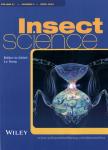The mitochondrial genome of the plant bug Apolygus lucorum (Hemiptera: Miridae)" Presently known as the smallest in Heteroptera
The mitochondrial genome of the plant bug Apolygus lucorum (Hemiptera: Miridae)" Presently known as the smallest in Heteroptera作者机构:Department of Entomology China Agricultural University Beijing Research Center of Hongta Group Yuxi Yunnan China
出 版 物:《Insect Science》 (昆虫科学(英文版))
年 卷 期:2014年第21卷第2期
页 面:159-173页
核心收录:
学科分类:0710[理学-生物学] 07[理学] 09[农学] 071007[理学-遗传学] 0904[农学-植物保护] 090401[农学-植物病理学] 0901[农学-作物学] 090402[农学-农业昆虫与害虫防治] 090102[农学-作物遗传育种]
基 金:This research is supported by grants from the Special Fund for Agroscientific Research in the Public Interest (Nos. 201103012 201103022 201303024) National Ba- sic Research Program of China (No. 2013CB 127600) the Natural Science Foundation of Beijing (No. 6112013) the special Foundation for Scientific Research (No. 2012FY 111100) and the National Natural Science Foun- dation of China (Nos. 1061160186 31111140015)
主 题:Apolygus lucorum Cimicomorpha Miridae mitochondrial genome phylo-genetic relationship secondary structure
摘 要:The complete mitochondrial (mt) genome of the plant bug, Apolygus lucorum, an important cotton pest, has been sequenced and annotated in this study. The entire circular genome is 14 768 bp in size and represents the smallest in presently known heteropteran mt genomes. The mt genome is encoding for two ribosomal RNA (rRNA) genes, 22 transfer RNA (tRNA) genes, 13 protein coding genes and a control region, and the order, content, codon usage and base organization show similarity to a great extent to the hypothetical ancestral model. All protein coding genes use standard initiation codons ATN. Conventional stop codons TAA and TAG have been assigned to the most protein coding genes; however, COIII, ND4 and ND5 genes show incomplete terminator signal (T). All tRNA genes possess the typical clover leaf structure, but the dihydrouridine arm of tRNAser(A6N) only forms a simple loop. Secondary structure models of rRNA genes are generally in accordance with the former models, although some differences exist in certain parts. Three intergenic spacers have never been found in sequenced mt genomes of Heteroptera. The phylogenetic study based on protein coding genes is largely congruent with previous phylogenetic work. Both Bayesian inference and maximum likelihood analyses highly support the sister relationship ofA. lucorum and Lygus lineolaris, and Miridae presents a sister position to Anthocoridae.



